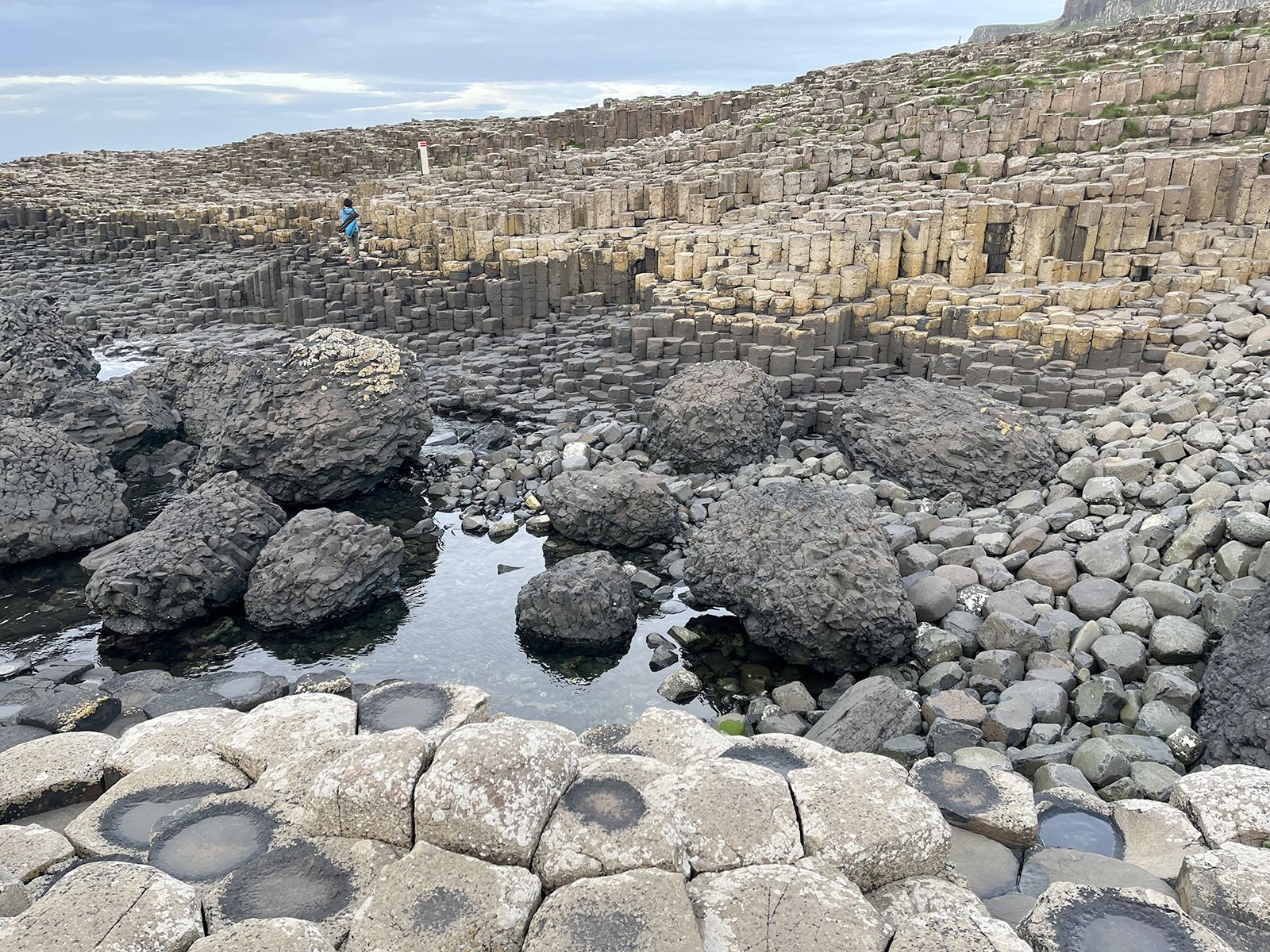You would be forgiven for being momentarily confused. Well, being confused if you were from the South. We southerners typically refer to Northern Ireland as “The North.” So when a road sign comes into view on the northern outskirts of Belfast indicating the route to “The North” you would be forgiven for that moment’s confusion.
The walk in.
But here in the North there is another North, and it is the land that stretches from the city by the Lough to the end of the roads that take you to the Atlantic Ocean. And take you to the Giant’s Causeway. Like most people these times I have a travel bucket list.
There will not be enough years available to empty the bucket, but we can but try. I must confess that the Giant’s Causeway was not near the top of said bucket, but an opportunity presented itself in the autumn of 2023. So it was a case of carpe diem and carpe the steering wheel.
The famed writer Doctor Samuel Johnson (1709-1784) famously, or infamously, remarked that the Giant's Causeway was "worth seeing, but not worth going to see.”
Iceland this way, Scottish Isles that way.
Dr. Johnson was top of the pile and tip of the quill when it came to penning pithy lines that would echo down the centuries.
But he didn’t finish this particular line. He failed to add at its end: “by horse.” And if by horse, or in a horse-drawn carriage, I would be right with the man. It is 61 miles from Belfast to the Causeway, so the wonders of the final destination could easily be lost on the saddle-sore pilgrim.
All hail the combustion engine, bad for the climate though it remains. That 61 miles is a series of Irish long miles. The journey feels more stretched out than you expected and it is only when you roll into the village of Bushmills, of whiskey fame, that you have the sense of being close, not just to the Causeway, but to the north Antrim coast, a rugged edge of the island of Ireland that is itself more than well worth traveling to see.
And that is the heart of the matter. The Giant’s Causeway is part of a greater whole, a highlight among a range of local landmarks that stretch from Fair Head in the east to Portrush in the west. And beyond if you like.
A Causeway high point.
But of the Causeway itself. Well, if you want to get scientific about it, the Causeway is an area of roughly 40,000 interlocking basalt columns that date to a volcanic eruption back in the mists of geologic time, roughly 50 to 60 million years ago. It is a UNESCO World Heritage site.
The tops of the columns, the official description attests, form stepping stones that lead from the cliff foot and disappear under the sea.
Most of the columns are hexagonal, although some have four, five, seven, or eight sides. The tallest are about 12 meters (39 feet) high, and the solidified lava in the cliffs is 28 meters (92 feet) thick in places. But enough of science.
Another account of the place is rather more captivating. As legend would have it, the columns are the remains of a causeway built by the Irish giant Finn MacCool so that he could cross the North Channel to take on Scottish giant Benandonner.
Looking northward.
This story must have seeped into the minds of global public imagination because visitors to the Causeway do actually ask if it was man made - this presumably because it looks so ordered and purposeful and not the kind of random chaos you might expect after a volcanic cataclysm.
So the causeway is something of a puzzle, a natural presentation of geologic building blocks that looks, well, unnatural. Beyond the interlocking basalt columns there is the broader setting.
The north Antrim coast is a stunning stretch of land abutting an ocean that stretches into seeming infinity. And the visitor walks a stretch of that coast from the parking lot. Actually there are two of those, one serving the visitor center, the other the nearby Causeway Hotel.
Both charge a few pounds but if by chance the visitor center is beyond its hours, or if its parking lot is full, the hotel is an adjacent option.
The Chimney Stacks.
This will cost you ten pounds but the receipt can be later used as a food and drink voucher should the visitor decide to tarry awhile after checking out all those basalt columns. And you will work up an appetite, what with the walk to and from the Causeway and all the stepping up and down once the Causeway has been attained.
The geological wonder is set against the backdrop of cliffs that form a rampart that even a giant would find hard to scale. This vertical wall elevates a sense of isolation.
You feel cut off from the Antrim landscape on one side, and hemmed in by the ocean on the other. In this context isolation is a positive. The setting is large enough to accommodate even a large number of visitors though of course “large” can vary with time of year.
We were there in October and there was, late in the day, still a respectable number of the well-traveled and curious. Time of year and time of day delivered a sense of loneliness in a way. As much as the Causeway is a sight to see, the surrounding cliffs and sea are compelling companions.
There is a plaque with an arrow pointing to Iceland, an arrow pointing to the rather closer Scottish Isles. The Causeway is indeed a link, if not a literal bridge.
What you see of it, what you can step on and over, of course depends on the tides. If sea levels rise as being currently predicted the future might result in the Causeway columns, or at least some of them, being less visible and regardless of tide. So better to visit sooner rather than later.
And perhaps in an electric car so as not to add to the Causeway’s peril. At the end of it all, the walking and sightseeing, the careful examination of the Causeway’s stacked stepping stones, it was time to conclude the expedition in the Causeway Hotel.
The parking ticket and a little extra was exchanged for sustenance, in this instance filling bowls of excellent chips (fries) and well poured pints of Guinness. Dr. Johnson might have revised his assessment if he had so eaten and imbibed.
A final judgment. Was the great writer and thinker correct in his assertion, or was he being simply cranky? We can settle on cranky. The Giant’s Causeway is well worth the visit, well worth the drive from wherever on the island you start from. Sure, it doesn’t match the scale of the Grand Canyon, or Mount Everest. But neither does the Mona Lisa.
More at https://www.nationaltrust.org.uk/visit/northern-ireland/giants-causeway








